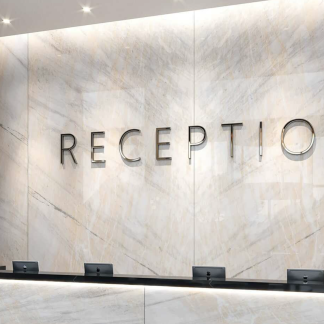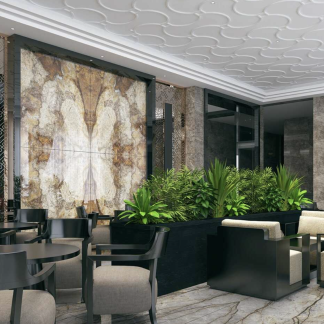Marble
Durable and elegant, marble is one of the most popular natural stones. From kitchen countertops to floor tiles, you can use this mesmerizing stone on many different surfaces. If you’d like to know more about pros and cons of granite surfaces, keep reading.
Marble slabs have been the symbol of sophistication and opulence throughout the history. From Taj Mahal to Library of Celsus, many historical buildings and structures employ this gorgeous natural stone.
If you want to welcome the elegance of marble into your home, there are certain things you should know about this beautiful material. Keep reading to learn more.
What is marble?
Marble is a very hard and durable metamorphic rock that is widely used as tiles and countertops. It comprises various carbonate minerals such as calcite and dolomite. Following a metamorphism process, carbonate crystals are formed thus creating gorgeous marble blocks.
In addition to calcite and dolomite, marble also contains different minerals and materials such as sand, clay, serpentine, silt, chert, sand and so forth. These secondary minerals and materials give marble blocks their unique colors and eye-cathcing veins.
There are many different types of marble characterized by their color and origin:
-
Pentelic Marble: This marble type has a dignified pure white color and is found in Attica and Mount Pentelicus region of Greece.
-
Creole Marble: Found in Pickens County, Georgia, Creole marble has an impressive white and blue/black color.
-
Hanbaiyu Marble: This marble is known for its exquisite white color and found in Quyang County region of China.
-
Etowah Marble: Native to Pickens County, Georgia, this marble is known for its soft, pinkish color.
-
Nero Marquina Marble: Found in Markina region of Spain, this marble is famous for its extravagant black color which suits modern interior design styles.
-
Carrara Marble: Native to Tuscany region of Italy, Carrara marble comes in two different colors: White or blue-gray.
-
Ruskeala Marble: Having a classic, white color, Ruskeala marble is native to the Karelia region of Russia.
-
Bianco Sivec Marble: One of the most popular white marbles, Bianco Sivec is found in Pelagonia region of North Macedonia.
-
Swedish Green Marble: As its name suggests, this marble has a stunning green color and is found in Södermanland region of Sweden.
-
Prokonnesos Marble: Found in Marmara region of Turkey, Prokonnesos marble has a pure white color.
Marble Colors
The variation of the chemical components of a marble block determines its color: You can find gorgeous marble slabs in white, off-white, black, green, brown, gold, red, cream, blue, yellow, Calcutta, and grey.
Since marble is a natural stone, each marble slab has a unique shade and vein pattern. That is why there are no two marble slabs that are identical. If you want to express your unique taste in interior design, marble is a dazzle material that will leave you absolutely satisfied.
Marble Countertops
Marble stone is often used in kitchen countertops and marble tiles. Although very hard, marble is a porous stone. That is why it requires great care and regular maintenance.
Staining agents like wine, oil or juice must be kept away from marble surfaces. Moreover, marble countertops and marble tile countertops require regular sealing.
If you like the upscale look of this impressive natural stone and don’t mind the maintenance requirements, marble is the perfect choice for you.
If you’d like to know more about marble countertops and marble suppliers near you, feel free to get in touch with us.










